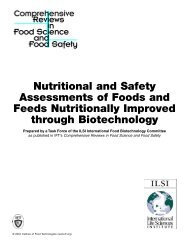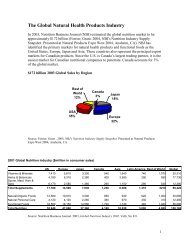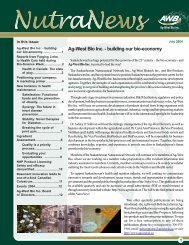Beyond Borders: Global biotechnology report 2010
Beyond Borders: Global biotechnology report 2010
Beyond Borders: Global biotechnology report 2010
You also want an ePaper? Increase the reach of your titles
YUMPU automatically turns print PDFs into web optimized ePapers that Google loves.
China year in review<br />
Accelerating reforms<br />
It is evident that China will be an<br />
increasingly important market for<br />
<strong>biotechnology</strong> and pharmaceutical<br />
products and companies in the years<br />
to come. Indeed, it is now considered<br />
essential for companies with commercial<br />
operations or aspirations to formulate<br />
a strategy for the Chinese market — a<br />
market currently dominated by generics<br />
(including generic versions of Western<br />
biologic drugs) and traditional Chinese<br />
medicines (TCMs). Meanwhile, the<br />
Chinese Government is encouraging the<br />
development of a domestic innovative<br />
<strong>biotechnology</strong> sector through a combination<br />
of direct investment, intellectual property<br />
reforms and commercial incentives. Yet<br />
for all the promise, the sheer volume of<br />
change — driven both by market dynamics<br />
and Government reforms — is daunting,<br />
creating uncertainties for investors in<br />
China’s biotech sector.<br />
Growth and consolidation<br />
China’s pharmaceutical market continues<br />
to post impressive year-over-year<br />
growth driven by macro trends — an<br />
aging population, Government programs<br />
to significantly broaden access to<br />
medicines, increasing personal wealth<br />
and the increasing incidence of “middle<br />
class diseases,” such as diabetes and<br />
hypertension. A recent IMS Health <strong>report</strong><br />
pegged the market’s annual growth rate<br />
at 27% from 2006 to 2009 and projected<br />
that China would surpass Germany and<br />
France to become the third-largest drug<br />
market in the world by 2011 (behind only<br />
the US and Japan).<br />
At present, the industry is highly<br />
fragmented, with several thousand<br />
domestic manufacturers and distributors<br />
competing alongside most of the major<br />
multinational companies from the US,<br />
Europe and Japan. To boost efficiency and<br />
quality, the Government is encouraging<br />
consolidation of the domestic industry,<br />
partially through changes to the drug<br />
distribution system and price reforms.<br />
It is aiming to reshape the industry with<br />
fewer financially strong entities that have<br />
the scale necessary to undertake national<br />
distribution and investments in innovative<br />
R&D and, eventually, compete globally<br />
through exports.<br />
<strong>Beyond</strong> the market opportunity, China<br />
remains a highly attractive outsourcing<br />
destination in terms of cost efficiency and,<br />
increasingly, patient availability for clinical<br />
trials, expertise and infrastructure.<br />
Essential reform<br />
In March 2009, China adopted a massive<br />
reform of the health care system,<br />
committing RMB 850 billion (US$124<br />
billion) over the next three years to<br />
increase health insurance for the<br />
non-employed urban and rural<br />
populations. While health care reform<br />
was driven by the realization that a<br />
healthy population is necessary to<br />
sustain economic growth, the 2009<br />
policies were accelerated by the global<br />
recession. Chinese leaders concluded<br />
that the country needed to decrease its<br />
dependence on exports while maintaining<br />
employment levels through encouraging<br />
domestic consumption. The Chinese<br />
population has historically had a very<br />
high savings rate, in part to save for<br />
unexpected and uncovered medical<br />
expenditures; thus, providing greater<br />
30 <strong>Beyond</strong> borders <strong>Global</strong> <strong>biotechnology</strong> <strong>report</strong> <strong>2010</strong><br />
health coverage will presumably free up<br />
capacity for non-health related spending.<br />
The increased coverage will lead to higher<br />
pharmaceutical sales, but distribution<br />
to second- and third-tier cities and rural<br />
populations will remain a challenge for<br />
many manufacturers.<br />
<strong>Beyond</strong> health insurance coverage, the<br />
Government is also addressing the drug<br />
distribution process itself as part of the<br />
reform efforts. A significant majority<br />
of drug sales are now made through<br />
state-owned hospitals. Hospitals depend on<br />
the margin from these sales (generally 15%)<br />
to fund their operations and are therefore<br />
motivated to prescribe higher-priced<br />
medicines to maximize the margin earned.<br />
This drives up overall system costs and<br />
creates an environment that encourages<br />
improper sales practices.<br />
Finally, in August 2009, China updated<br />
its Essential Drugs List (EDL), which<br />
includes 307 medicines that will be given<br />
priority from a usage and reimbursement<br />
standpoint. Approximately two-thirds of the<br />
EDL is composed of products discovered and<br />
developed outside China (most of which are<br />
available in generic form in China already)<br />
and one-third is composed of TCMs. The<br />
Government will set the prices for drugs on<br />
the EDL, which will put a premium on costeffective<br />
manufacturing and distribution and<br />
generally benefit larger players. Innovative<br />
and patented drugs sold by multinational<br />
companies will continue to be funded largely<br />
by patients.<br />
Despite their higher cost, brand-name<br />
drugs that no longer have patent protection<br />
are often favored by populations in more<br />
affluent urban settings as they are<br />
perceived to be of higher quality than<br />
generic competitors.








